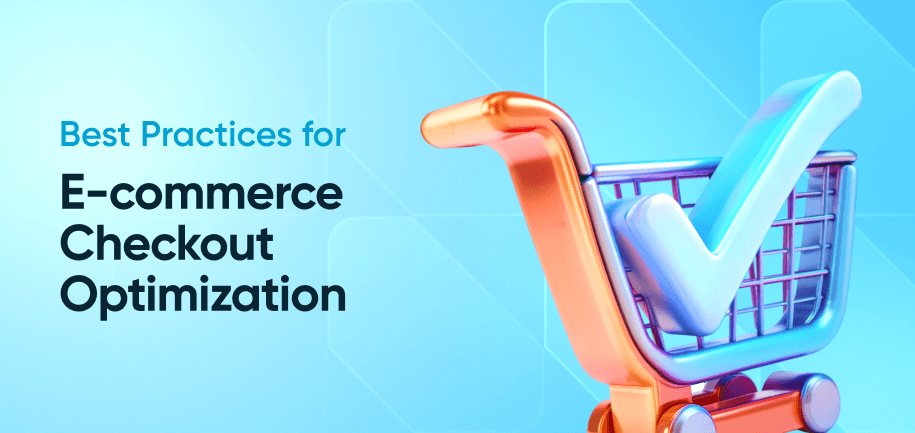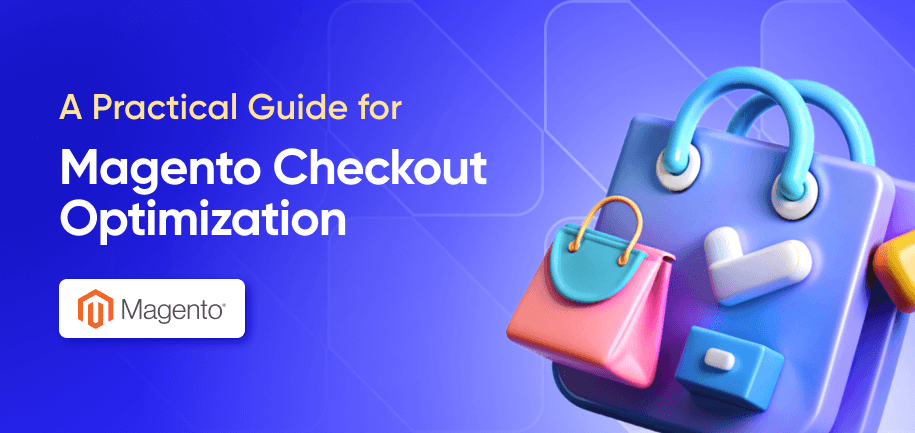Have you been facing low conversion rates at your store? If yes, then you are not alone. According to statistics, the global cart abandonment rate for e-commerce is nearly 70%. There are many reasons why shoppers choose not to buy your products after they have added the products to their carts, including:
- Hidden charges
- Complex checkout process
- Poor choice of payment options
- Lack of motivation to make the purchase immediately
- Non-interactive forms
- Obligatory account creation
- No price protection guarantee.
In this article, we will go through how you can address these issues and optimize your e-commerce checkout page by taking just ten actionable steps.
What is Checkout Optimization?
Checkout optimization is the process of improving every element of your online store's final purchase step to minimize friction and maximize conversion. This includes refining the layout, reducing steps, improving loading times, offering diverse payment methods, and removing unnecessary distractions.
The goal is to create a high-converting checkout page that delivers a seamless checkout experience and reduces cart abandonment.
Read More: What’s a Good E-commerce Conversion Rate? Latest Stats
Why is Checkout Optimization Important?
An optimized checkout can make or break a sale. No matter how excellent your product is or how effective your marketing strategy has been, a poor checkout experience can lead to customer drop-offs at the final stage.
When you invest in e-commerce checkout optimization, you not only enhance user satisfaction but also increase checkout conversion, encourage repeat purchases, and boost revenue. In fact, businesses with the best checkout experiences tend to outperform competitors when it comes to conversion metrics.
Read More: How to Optimize Checkout in Magento
10 E-commerce Checkout Page Best Practices
To make the best of your checkout page, you should fine-tune every element of the checkout process. Below, we’ll explore ten e-commerce checkout page best practices designed to help you create a high-converting checkout page.
1. Secure Your Website with an SSL Certificate
Security is a top concern for online shoppers, especially during checkout. Consumers are increasingly aware of the cyberattack risks, and 71% say they would stop doing business with a brand after a data breach.
To build and maintain trust, your website must demonstrate that it’s secure. The foundation of this is an SSL certificate, which encrypts sensitive information shared between the user’s browser and your server. For maximum trust and visibility, consider installing an Extended Validation (EV) SSL certificate. This certificate displays a green padlock and your company name in the address bar – strong visual cues that your business is verified and safe.
In addition to trust, SSL also brings SEO benefits. Secure websites are favored by Google, and SEO-driven leads have a 14.6% close rate, significantly outperforming outbound methods. In short, SSL is critical for checkout page optimization, both from a user trust and visibility perspective.
2. Display Shipping Cost Upfront
Unexpected costs are one of the leading causes of cart abandonment. According to the Baymard Institute, 48% of shoppers abandon carts because extra costs (like shipping and taxes) are too high or weren’t shown early enough. To deliver the best possible checkout page experience, it’s essential to be transparent about all fees, especially shipping.
Displaying shipping costs upfront prevents frustration and builds trust. If shoppers only see the true total at the final step, they’re more likely to feel misled and exit the process. Instead, consider offering real-time shipping estimates as soon as a product is added to the cart or as part of the cart view.
One effective solution is to integrate a shipping calculator directly on your product pages or shopping cart. Let users select their location or enter their ZIP code to get accurate shipping estimates before they proceed to checkout. This creates a sense of control and clarity for the shopper, which contributes to a more user-friendly checkout flow.
Additionally, offer free shipping and highlight thresholds early on. For example, displaying “Free shipping on orders over $50” near the “Add to Cart” button can encourage customers to increase their cart value and helps set clear expectations. You can even use dynamic messages in the cart like “Add $12 more to get free shipping.”
If possible, offer multiple shipping options – standard, expedited, or overnight – along with clear pricing and estimated delivery times. This empowers customers to choose what works best for them and reduces friction.
3. Simplify the Checkout Process
Complex checkout forms and multi-step processes can easily frustrate users and lead to cart abandonment. As many as 17% of online shoppers abandon their carts if the checkout process is too long or complicated, according to Baymard. Streamlining your checkout is key to reducing friction and boosting conversions.
Take Sierra Designs as a good example – they optimized their checkout page to display a clear order summary, minimal distractions, and a straightforward “Next Step” CTA. This clarity helps users focus and move forward without second-guessing the process.

Consider using tools similar to One Step Checkout. They allow you to condense the entire checkout process onto a single page. Customers can fill out the billing address, shipping address, and payment information in one unified view. This minimizes loading times between steps.
Also, analyze your checkout funnel using analytics tools to identify where users drop off. A/B testing layout changes, form field reductions, and CTA placements can help fine-tune the customer experience.
In short, a simplified checkout process reduces user fatigue, increases conversion rates, and contributes to a smoother, more satisfying shopping process.
4. Show Progress Indicators
Uncertainty kills conversions. If users don’t know how long the process will take, they may quit midway. A simple solution is adding a progress bar or step indicator to the checkout process.
This visual cue reassures users that they're moving forward and nearing completion. It's a small but powerful way to improve the checkout process, reduce anxiety, and keep users engaged until the final click. Transparent navigation is one of the overlooked checkout page best practices that builds confidence and encourages completion.
5. Auto-Save Cart and Inputs
Cart abandonment doesn’t always mean lost interest – sometimes users get interrupted. But if the cart or form inputs reset, chances are they won’t start over.
Enable auto-save features that retain cart contents and filled-out data for returning users. This way, shoppers can resume where they left off. This tactic not only improves the checkout experience but also contributes to checkout conversion optimization by removing unnecessary repetition. It shows that your store values convenience and customer time.
6. Offer Multiple Payment Options
Payment flexibility is a core requirement for modern e-commerce checkout optimization. According to Baymard Institute, roughly 25% of U.S. shoppers abandon their carts if their preferred payment method isn't available. In other words, if you don’t support the way a customer wants to pay, they may simply walk away.
Traditionally, offering credit and debit card payments was enough. But with the rise of digital wallets, Buy Now Pay Later (BNPL) services, and localized payment platforms, consumer expectations have shifted. Today’s online shoppers want convenience, speed, and control at checkout regardless of the device they’re using.
Here are the key payment methods to consider integrating into your e-commerce store:
- Credit/Debit Cards – Still essential and expected by nearly all online shoppers.
- Digital Wallets – Options like Apple Pay, Google Pay, PayPal, and Samsung Pay provide a seamless experience, especially on mobile.
- BNPL and Layaway Services – Providers like Klarna, Afterpay, and Affirm allow shoppers to split payments over time, especially appealing to younger audiences and during peak shopping seasons.
- Local and Regional Methods – In global e-commerce, offering region-specific options such as iDEAL (Netherlands), Boleto (Brazil), or Alipay (China) can unlock growth in new markets.
Offering multiple payment options not only caters to user preferences but also reduces checkout friction. When customers recognize their preferred method on your checkout page, it builds trust and improves the likelihood of completing the purchase.
It also plays a role in security and compliance. For example, Stripe Payment Gateway supports 3D Secure 2.0 and helps merchants meet PSD2 and Strong Customer Authentication (SCA) requirements in the EU. This ensures that every transaction is both user-friendly and secure, helping you build a reputation for reliability.
On top of that, modern payment plugins and gateways are built to integrate easily with your e-commerce platform. Many offer tokenized payments for quicker repeat purchases, and some even support features like one-click checkout or saved payment methods to improve user experience further.
7. Create Urgency
Creating urgency is one of the most effective ways to increase checkout conversion. When shoppers feel they might miss out, they’re more likely to act quickly. This sense of urgency can be triggered through several proven tactics:
- Countdown timers that show how long a deal is valid
- Low-stock alerts that highlight limited availability
- Flash sales with steep, time-sensitive discounts

These strategies tap into consumer psychology and reduce hesitation during the decision-making process. Not only do they speed up conversions, but they also contribute to a high-converting checkout page by removing delays and indecision.
8. Make Your Forms More Interactive
Interactive forms play a huge role in creating a seamless checkout experience. When forms are intuitive and visually appealing, users are more likely to complete the purchase without friction.
One popular technique is using floating labels, which move above the input field as users begin typing. These labels reduce clutter, save vertical space, and help maintain context, improving the perceived ease of form completion.
Interactive forms can also include real-time validation, auto-fill capabilities, and inline assistance to prevent errors and guide users through the checkout process optimization. Together, these elements minimize frustration, making your checkout page more user-friendly and efficient. Ultimately, a well-designed form improves the checkout experience and supports overall checkout page optimization efforts.
9. Remove the Obligatory Account Creation Process
Many users simply want to complete their purchase quickly without the hassle of creating an account. Forcing account registration can disrupt the checkout flow and result in abandonment. Enabling guest checkout helps reduce friction, especially for first-time buyers.
To improve the checkout experience, provide a clear choice: checkout as a guest or sign in. You can still offer account creation after the purchase is complete, when the customer is already satisfied. This small change supports a more seamless checkout experience and can significantly increase checkout conversion.
10. Offer Price Protection Guarantee
Price sensitivity is real. Shoppers want to know they’re getting the best deal. Displaying a price protection guarantee or price history builds trust and encourages users to complete their purchase. If they know they can get a refund if the price drops, they’re more likely to buy now.

To complement this, make sure your return and refund policy is easily visible. The RMA extensions help create a seamless returns experience – another key factor in building trust and improving your online checkout.
E-commerce Checkout Optimization – Takeaways
The 10 tips mentioned above are not exhaustive, but applying them will help you optimize your online checkout and deliver some of the best checkout experiences your customers could ask for.
Just creating a product and attracting a large audience isn’t enough. You need to provide a smooth and intuitive checkout process optimization strategy to turn those visitors into paying customers.
Over 80% of online shoppers abandon brands after a poor experience, and 33% of American customers consider switching companies after just one bad interaction. Make it your mission to deliver a seamless checkout experience every time – and watch your conversion rates rise.
























